Nara (奈良市, Nara-shi, [naꜜɾa] ) is the capital city of Nara Prefecture, Japan. As of 2022, Nara has an estimated population of 367,353 according to World Population Review, making it the largest city in Nara Prefecture and sixth-largest in the Kansai region of Honshu. Nara is a core city located in the northern part of Nara Prefecture bordering the Kyoto Prefecture.
Nara was the capital of Japan during the Nara period from 710 to 794 as the seat of the Emperor before the capital was moved to Kyoto. Nara is home to eight temples, shrines, and ruins, specifically Tōdai-ji, Saidai-ji, Kōfuku-ji, Kasuga Shrine, Gangō-ji, Yakushi-ji, Tōshōdai-ji, and the Heijō Palace, toge...Read more
Nara (奈良市, Nara-shi, [naꜜɾa] ) is the capital city of Nara Prefecture, Japan. As of 2022, Nara has an estimated population of 367,353 according to World Population Review, making it the largest city in Nara Prefecture and sixth-largest in the Kansai region of Honshu. Nara is a core city located in the northern part of Nara Prefecture bordering the Kyoto Prefecture.
Nara was the capital of Japan during the Nara period from 710 to 794 as the seat of the Emperor before the capital was moved to Kyoto. Nara is home to eight temples, shrines, and ruins, specifically Tōdai-ji, Saidai-ji, Kōfuku-ji, Kasuga Shrine, Gangō-ji, Yakushi-ji, Tōshōdai-ji, and the Heijō Palace, together with Kasugayama Primeval Forest, collectively form the Historic Monuments of Ancient Nara, a UNESCO World Heritage Site.
There are a number of megalithic tombs or kofun in Nara, including Gosashi Kofun, Hishiage Kofun (ヒシアゲ古墳), Horaisan Kofun (宝来山古墳), Konabe Kofun (コナベ古墳), Saki Ishizukayama Kofun (佐紀石塚山古墳), Saki Misasagiyama Kofun (佐紀陵山古墳), and Uwanabe Kofun (ウワナベ古墳).
By decree of an edict on March 11, 708 AD, Empress Genmei ordered the court to relocate to the new capital, Nara.[1] Once known as Heijō or Heijō-kyō, the city was established as Japan's first permanent capital in 710 CE; it was the seat of government until 784 CE, albeit with a five-year interruption, lasting from 741 to 745 CE.[1][2] Heijō, as the ‘penultimate court’, however, was abandoned by the order of Emperor Kammu in 784 CE in favor of the temporary site of Nagaoka, and then Heian-kyō (Kyoto) which retained the status of capital for 1,100 years, until the Meiji Emperor made the final move to Edo in 1869 CE.[3][2][4] This first relocation was due to the court's transformation from an imperial nobility to a force of metropolitan elites and new technique of dynastic shedding which had refashioned the relationship between court, nobility, and country.[3] Moreover, the ancient capital lent its name to Nara period.[2]
As a reactionary expression to the political centralization of China, the city of Nara (Heijō) was modeled after the Tang capital at Chang’an.[4] Nara was laid out on a grid—which was based upon the Handen system—whereby the city was divided by four great roads.[2] Likewise, according to Chinese cosmology, the ruler's place was fixed like the pole star. By dominating the capital, the ruler brought heaven to earth.[5] Thus, the south-facing palace centered at the north, bisected the ancient city, instituting ‘Right Capital’ and ‘Left Capital’ zones.[3][5] As Nara came to be a center of Buddhism in Japan and a prominent pilgrimage site, the city plan incorporated various pre-Heijō and Heijō period temples, of which the Yakushiji and the Todaiji still stand.[3][4]
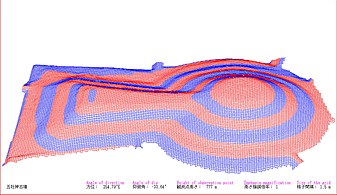
A number of scholars have characterized the Nara period as a time of penal and administrative legal order.[6] The Taihō Code called for the establishment of administrative sects underneath the central government, and modeled many of the codes from the Chinese Tang dynasty.[7] The code eventually disbanded, but its contents were largely preserved in the Yōrō Code of 718.[7]
Occupants of the throne during the period gradually shifted their focus from military preparation to religious rites and institutions, in an attempt to strengthen their divine authority over the population.[6]
Religion and temples Nanto RokushūWith the establishment of the new capital, Asuka-dera, the temple of the Soga clan, was relocated within Nara.[8] The Emperor Shōmu ordered the construction of Tōdai-ji Temple (largest wooden building in the world) and the world's largest bronze Buddha statue.[4] The temples of Nara, known collectively as the Nanto Shichi Daiji, remained spiritually significant even beyond the move of the political capital to Heian-kyō in 794, thus giving Nara a synonym of Nanto (南都 "the southern capital").
On December 2, 724 AD, in order to increase the visual "magnificence" of the city, an edict was ordered by the government for the noblemen and the wealthy to renovate the roofs, pillars, and walls of their homes, although at that time this was unfeasible.[1]
Sightseeing in Nara city became popular in the Edo period, during which several visitors' maps of Nara were widely published.[9] During the Meiji Period, the Kofukuji Temple lost some land and its monks were converted into Shinto priests, due to Buddhism being associated with the old shogunate.[10]


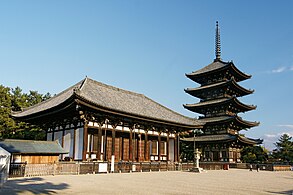
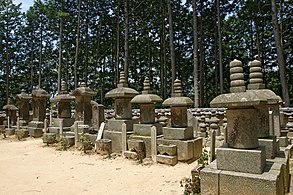

Although Nara was the capital of Japan from 710 to 794, it was not designated a city until 1 February 1898. Nara has since developed from a town of commerce in the Edo and Meiji periods to a modern tourist city, due to its large number of historical temples, landmarks and national monuments. Nara was added to the UNESCO World Heritage Sites list in December 1998.[11] The architecture of some shops, ryokans and art galleries has been adapted from traditional merchant houses.[10]
Nara holds traditional festivals every year, including the Neri-Kuyo Eshiki, a spring festival held in Todaiji temple for over 1,000 years; and the Kemari Festival, in which people wear costumes ranging across 700 years and play traditional games).[12]
In 1909, Tatsuno Kingo designed the Nara Hotel, whose architecture combined modern elements with traditional Japanese style.[10]
On 8 July 2022, former Prime Minister of Japan Shinzo Abe was shot and killed by Tetsuya Yamagami with a homemade firearm in Nara while campaigning.[13] There is currently an ongoing investigation into the assassination.[14]












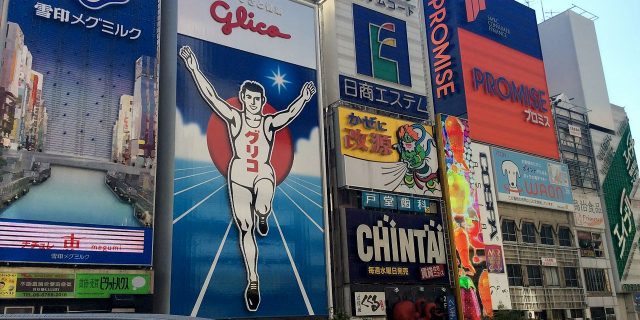











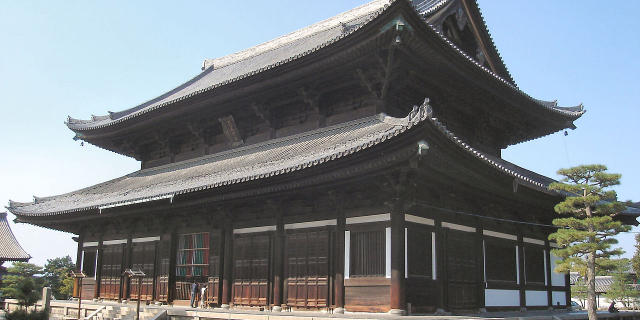






Add new comment